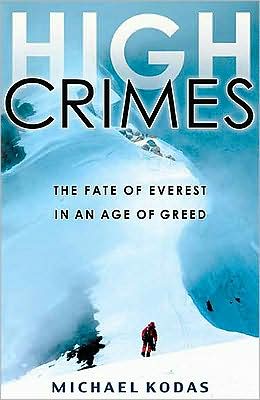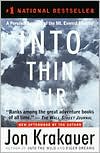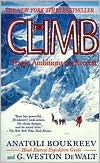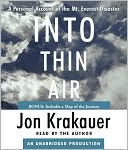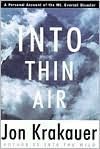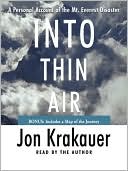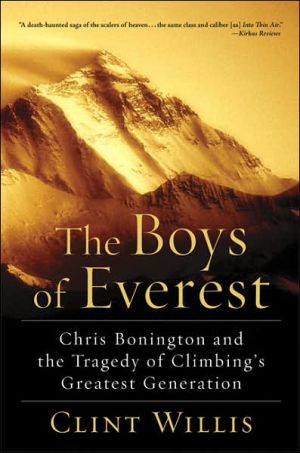High Crimes: The Fate of Everest in an Age of Greed
"The perfect follow-up to Krakauer's riveting account of a perfect storm."\ --Miami Herald\ "Kodas's absorbing description of the narrow moral compass governing human interaction at the top of the world is bound to shock both armchair adventurers and seasoned mountaineers."\ --Chicago Tribune\ "(Kodas) discovered more deceit, thievery, and double-crossing among his climbers than you find in a Martin Scorsese gangster film. High Crimes is both an adventure story and an expos of a sport riddled...
Search in google:
In the years following the publication of Into Thin Air, much has changed on Mount Everest. Among all the books documenting the glorious adventures in mountains around the world, and the unique perils and challenges of Mount Everest, none details how the recent infusion of wealth into the mountains is reacting with the age-old lust for glory to draw crime to the highest places on the planet, how a mountain's ability to reduce climbers to their essential selves is revealing villains as well as heroes, greed as well as selflessness. The change is caused both by a tremendous boom in traffic to the world's mountains and a new class of parasitic and predatory adventurer. It's likely that Jon Krakauer would not recognize the camps that he visited on Mount Everest almost a decade ago. This book will take readers on a harrowing tour of the criminal underworld on the slopes and peaks of the world's most majestic mountain. Some of the stories included here are the tragic story of Nils Antezana, a climber who died on Everest after he was abandoned by his guide. Also the author's own summit story, as he participated in the Connecticut Everest Expedition, which would never have followed George Dijjmarescu and Lhakpa Sherpa to the Himalaya had news of the couple's climb with the Romanian team the previous year made it to the United States. But as they neared the frigid peril of Everest, the charming couple turned increasingly hostile. Women on the team held little power and were instead threatened, stalked, and harassed before a final assault. By the end of the expedition, the three women with the team could not travel unaccompanied in base camp due to the threat of violence. Thosethat tried to stand against the violence, theft and intimidation found the worst of the peril they encountered on Everest had followed them home to Connecticut. Beatings, thefts, drugs, prostitution, coercion, threats, and abandonment on the highest slopes of Everest and other mountains have become the rule rather than the exception, and Kodas describes many of these experiences and explores the larger issues these stories raise with thriller-like intensity. The Washington Post - Allen Barra High Crimes is both an adventure story and an expose of a sport riddled with danger and corruption that have mostly gone unnoticed because so few can afford to play…Kodas's book is exhilarating, though at times a tad confusing. He doesn't make clear why his party's expedition unraveled, as if the rarefied air clouded his senses; he's better at the big picture…
HIGH CRIMES \ \ By MICHAEL KODAS \ Hyperion \ Copyright © 2008 Michael Kodas\ All right reserved.\ ISBN: 978-1-4013-0273-3 \ \ \ \ \ Chapter One \ MOUNT EVEREST, NEPAL-MAY 18, 2004 \ Along the highway of rope that leads above 8,000 meters on Mount Everest, the Balcony is probably the most accommodating rest stop, but Big Dorjee Sherpa and his teammates never planned on taking in the sunset from this perch. Climbers who see the end of the day here are often facing the end of their lives as well.\ Most climbers on the south side of the peak, in fact, hope to see the dawn rather than the dusk of their summit day from the frigid overlook that hangs 27,600 feet above sea level. Even at daybreak, they have been climbing for four or five hours by the time they get to this ridge of snow that stretches out like a runway toward the climb ahead. The rising sun bloodies the sky behind Makalu, the fifth-tallest mountain in the world, but the jagged tooth would be hard to miss even if it weren't so massive and highlighted in crimson and saffron: The peak of the Balcony's triangular ridgeline points directly at it. Below and to the south, the lighted tents of Camp Four, the highest camp on the route, glow yellow in the still-dark desolation of Everest's South Col, the highest refuge on the route in all but the most desperate of circumstances. To the north, the remote, immense, and relentlessly steep wall of the Kangshung Face stretches nearly two miles beneath the mountaintop, blushing with first light as it plummets into Tibet. Even mountaineers focused only on their ascent do well to take in this vista anyway. If they can't see these things, they probably shouldn't be here at all; the most benign clouds that obscue this view can turn deadly higher on the mountain.\ Those who continue up from the Balcony often take advantage of the wind break provided by a couple of large boulders at the edge of the ledge. They take off their backpacks for a few minutes, often sitting on them while they regroup. Virtually every face is hidden behind a mask connected to a tank of oxygen in their pack. At the Balcony, most climbers on oxygen take the bottle they are sucking on, unscrew it from the system's regulator, and spin a full bottle on in its place. There's often some gas left in that first tank, so they plant it in a carefully noted spot in the snow to retrieve on their return from the summit around midday. When they get back down, they'll switch their last bottle of oxygen, which is probably nearly empty, for the one they started with, using the dregs of that first tank's gas to get through the home stretch of their descent to the relative safety of the South Col. On a busy summit day, orange and blue oxygen bottles awaiting their owners' return poke up out of the snow like buoys bobbing in a wave. For mountaineers who arrive at the Balcony late, or exhausted or stormbound, that last bottle of oxygen can make the difference between survival and death. When Big Dorjee returned to the Balcony from the mountaintop that day, he and his teammates were all of these things. And sometimes, he knew, even a bottle of oxygen isn't enough to buoy a faltering climber.\ It had been more than six hours since the four-man team stood on the summit, and they had been climbing in the mountain's notorious "death zone" for more than twenty. Their descent had run hours late, and the other climbers who had made it to the summit that morning had been back in the shelter of the high camp for hours. Help was impossibly distant. Mingma Sherpa, standing beside his friend and coworker Dorjee, had made his first ascent to the top of Everest that morning. He knew enough to be terrified, but lacked the experience to recognize the myriad ways in which the mountain was trying to kill them. Dorjee, however, was coming down from his tenth trip to the top, and could see death coming at them from every direction.\ A cloud cap was dropping on top of the mountain, stirring up a fierce wind and threatening snow. Below them the dark shadows of night were climbing up the peak like frozen specters that would drop the temperature to 20 below zero or colder. Dorjee and Mingma's last oxygen tanks had run dry hours earlier. The man they would later say was dead when they left him grabbed at their legs like a zombie as they walked off the Balcony. But that was the least of their worries.\ More than six feet tall, Big Dorjee Sherpa towered over almost all the other Sherpa, who were normally diminutive. Dorjee grew up in Thame, a village some fifteen miles from Everest's south side Base Camp. For the people of the valley known as the Solu Khumbu, and residents of hamlets like Thame scattered about it, the big mountain had brought the highest standards of living in Nepal, and many villagers worked as porters or cooks for the mountaineers and trekkers who flooded the region. Others ran teahouses and lodges that catered to them. The Khumbu Valley's wealth shows in Dorjee's smile, which beams with a gold tooth from under his mustache-a product of the dental care that Sir Edmund Hillary and others had brought to the region, along with schools and medical clinics. Like a lot of Sherpas, Big Dorjee smiles a lot to compensate for his difficulty in speaking the languages of the climbers who hire him.\ Big Dorjee, age forty, started his career in the mountains as a yak driver, prodding trains of pack animals that were sometimes more than fifty beasts long up the steep, rocky, and airless trails. But Dorjee's stature and strength assured him other opportunities in the same way that a cum laude from Harvard opens doors in the States. His brother had worked for climbing teams, and by the early '90s, Dorjee had an invitation to work from one of the ever-increasing number of Everest expeditions that head to the peak every April. On his second expedition, he stepped onto the summit and into mountaineering's major leagues: A Sherpa who had climbed Everest had the best paycheck in the Khumbu, and was assured of work during the climbing season. In two months, Dorjee earned more than he could in a full year of herding yaks. That income had allowed him to move his family to Kathmandu and send his two daughters to school, a path of economic and social advancement followed by dozens of other climbing Sherpas.\ In the eyes of Manuel Lugli, the Italian expedition organizer who had arranged his current assignment, Big Dorjee was clearly an asset. Three months earlier, he had described him in an e-mail to his clients, Gustavo Lisi and Nils Antezana.\ Dorjee Sherpa, 40 years old, very, very strong and experienced. He has climbed on Annapurna IV, Makalu, Cho Oyu, Kanchenjunga, and above all has been on Everest 15 times, arriving at the summit 9 times (!), the last in the past year with my expedition.\ The word "Sherpa" has so many uses, it's hard to grasp. The Sherpa are an ethnic group that migrated from Tibet to Nepal a few hundred years ago. The title is also the last name of most members of the tribe-which leads to confusion that is further exacerbated by the tribe's custom of naming children after the day of the week on which they are born. And in the last fifty years, Western mountaineers have appropriated the name Sherpa as a job description for mountaineering porters, who are often, but not always, members of the tribe. The word carries strong connotations of hard work, loyalty, and honesty, and most Sherpas still live up to that part of their name: Almost all Himalayan climbers readily admit that they would have little chance of success without the assistance of Sherpas.\ From the beginning, the Bolivian-American doctor and the Argentine guide who had hired Dorjee and Mingma seemed an unlikely couple. Nils Antezana, a slender physician with salt-and-pepper hair, was reserved and polite, even to the most ragged of the porters who hauled their hundreds of pounds of equipment to the mountain. To Dorjee, as well as to most of the other climbers Nils met on Everest that spring, he looked like he was a few years beyond fifty. He didn't boast of the fact that, at sixty-nine, he would be the oldest American to reach the top of the world, or that he wore the same pants size that he had when he was forty years younger. His pride in his fitness was something he kept to himself. Each year higher-profile climbers set youth and age records, broadcasting the news around the world from the summit, but it would be a week before even Nils's teammates learned his actual age.\ His guide, an Argentinean named Gustavo Lisi, however, didn't mind boasting. The thirty-three-year-old seemed to step right from the mold of the rock-star mountaineer, turning his thumb up for photos, throwing his arm around campmates, and recounting his climbs in South America and his previous climb to the top of Everest four years earlier, in 2000. Other climbers on the mountain knew the story behind Gustavo's previous trip to Everest and some of his climbs in the Andes, but they didn't like to talk about them. Big Dorjee and Mingma would have heard few of his tales-Gustavo didn't speak English; Dorjee and Mingma spoke no Spanish. Nils had to translate all but the simplest of instructions between his guide and the two assistants. Although Gustavo was the guide, Big Dorjee and Mingma quickly figured out that Nils was the man who was paying for everything, and that made him the boss-even if he rarely gave them any orders of his own. The two Sherpas didn't mind that Gustavo spent little time with his client, Nils, often leaving them to lead the doctor up the mountain. The soft-spoken doctor was easy to get along with and put far fewer demands on them than the Argentinean. It was Nils's first time on Everest, so he would have had little idea what to ask of them, even if he had been more demanding by nature. Hanging out with him was not only more amicable, but might entitle the Sherpas to the kind of hefty tips and bonuses-$2,000 or more each-that they knew Nils's guide couldn't afford.\ But as soon as the team had stepped on top of Mount Everest, Big Dorjee realized that it was unlikely they would see a tip at all.\ Witnesses and team members say the group reached the summit of Everest just after ten a.m. on May 18, 2004. They agree on little else. Dorjee claims they had been climbing for only ten hours, meaning the team would have started their summit bid at midnight, but other climbers saw the group leave camp on the South Col a little after eight o'clock the night before.\ "I have finished equipping myself, it's eight at night and we are ready to leave for the summit," Gustavo reported by satellite telephone to his Web site before heading out.\ Although ten a.m. is a reasonable time to summit, with an eight p.m. start, they had been climbing nonstop for fourteen hours when they reached the top-the halfway point of any summit day. They would need nearly half that amount of time to climb back down to their tents ... if everything went well. The team had planned to make their round trip to the summit from Camp Four the previous day, when forecasts sent to the mountain by satellite predicted sunny skies and calm winds. They chose instead to spend that day resting. By the time they headed out from Camp Four on the evening of May 17, the weather report that had called for favorable conditions for several days had deteriorated. But at the summit, Big Dorjee didn't have time to worry about the turn in the weather; only the storm that seemed to be descending on his client's brain.\ The doctor had been slow climbing up, but Dorjee says he didn't notice anything in his client's behavior to indicate that he was suffering from altitude sickness. Nonetheless Dorjee had repeatedly tried to turn the team around, complaining to both the doctor and his guide that they were climbing too slowly to make it to the summit and back down safely. Neither was willing to retreat.\ But on top, Dorjee says, the doctor stumbled toward the edge of the summit and looked as if he were going to jump off. Then Nils pulled off his oxygen mask and lay down on his back on the snow. During the more than forty-five minutes that Nils, Gustavo, and their Sherpa assistants stayed on the summit-an unusually long time for a team that arrived there late in the morning on a day with unstable weather-Dorjee says he could hardly get the doctor to stay on his feet.\ "He's going mad," Dorjee recalls thinking.\ Gustavo, however, says he saw none of this.\ The guide was busy making photographs and videos of the vistas from the summit and of himself standing amid them, but says he would have noticed a climbing partner in such obvious distress. The only indications that Nils was in trouble, Gustavo says, were that Nils asked him why he had his headlamp turned on when the guide wasn't wearing one and that the doctor took several seconds to wave to the video camera after Gustavo asked him to. The video, which passes over Nils for just those few seconds, is the only record Gustavo made of his client on the summit, although members of another team that also made it to the summit that morning took a photo of Nils kneeling and waving to them from the top. He doesn't appear mad or sick in any of the images.\ Once the team began its descent, however, it was clear that Nils would need assistance from all three of his teammates to make it back down.\ The doctor was disoriented, had difficulty seeing, and staggered drunkenly as he walked, wobbling and stumbling down the narrow ridge of snow. Dorjee and Mingma stayed on either side of him, steering him downhill, clipping him into the ropes that were anchored to the route home and holding his arms to support him when his legs seemed ready to buckle. Gustavo joined them to help with the most difficult sections, but Dorjee says the guide was usually a few steps in front of them. By the time the team had descended two hundred feet below the summit, wherein lies the most difficult section of the climb-the forty-foot bluff of snow, ice, and rock known as the Hillary Step-Nils had collapsed. Dorjee pulled a rope from his pack, and the Sherpas lowered the doctor down the headwall. But three hours later the team had made it only another hundred feet down the mountain to the South Summit, where Nils nearly tumbled off the ridgeline. In the meantime, the weather had begun to turn in earnest, and the wind often knocked the climbers off balance. Gustavo's last bottle of oxygen-he and the Sherpas planned on using only two bottles each, but brought five for their client-ran dry.\ As the Sherpas held tight to their struggling client, they looked up to see Gustavo stepping away from them, pointing at Mingma and waving for him to come down the mountain with him. But Mingma stayed put, and the two Sherpas watched as the guide turned and began walking down the mountain without them. Dorjee had become accustomed to Gustavo racing ahead of his teammates, but he was shocked that the guide would leave them when the life of the man who had paid his way to Everest was hanging by a thread.\ Gustavo claimed later that Dorjee told him to move ahead to clear the ropes of ice and snow, but Dorjee says he told him nothing-they don't speak the same languages. Dorjee says Gustavo was soon out of sight a few hundred meters in front of them. Gustavo would claim, at different times, that he was only forty meters or fifteen meters away. But with the entire team debilitated by hypoxia and exhaustion, he might as well have been on another planet.\ When Dorjee, Mingma, and Nils made it back to the Balcony, 1,500 feet below the summit, Dorjee says the doctor collapsed again. Nils was unconscious much of the time now, the Sherpa said, and when he came to, he spoke gibberish. They tried to give him water, but it just dribbled down his chin. Now, they realized, all three of their lives were at stake. It would take most of the night for the Sherpas to drag an incoherent climber down to camp and, by then, all of them might succumb to the cold, the wind, and the lack of something to breathe.\ On the Balcony, Dorjee and Mingma found a bit of shelter behind a block of snow and leaned Nils against it. Then Dorjee says he took the team's last two oxygen bottles from his pack. Although he, Mingma, and Gustavo had all run out of oxygen, they say they did not consider using their employer's remaining two bottles of gas themselves and, although it was almost certain he wouldn't use them, they left them with him. If Nils came to, if by some miracle he got back on his feet, he would have plenty of oxygen to get himself down. If someone could mount a rescue, it was that much bottled gas they wouldn't have to carry up the mountain. As he planted the oxygen tanks into the snow, plainly within the doctor's sight and reach, Dorjee saw a flicker of recognition in Nils's dazed and goggled eyes. Even if he couldn't pick up the bottles that would save his life, he already grasped what they signified. They were leaving him. Mingma took off the down jacket he was wearing and wrapped it tightly around the delirious doctor. But as they prepared to go, Nils protested.\ (Continues...)\ \ \ \ \ Excerpted from HIGH CRIMES by MICHAEL KODAS Copyright © 2008 by Michael Kodas. Excerpted by permission.\ All rights reserved. No part of this excerpt may be reproduced or reprinted without permission in writing from the publisher.\ Excerpts are provided by Dial-A-Book Inc. solely for the personal use of visitors to this web site. \ \
\ Bruce BarcottHigh Crimes looks at the mountain through the eyes of a fascinated and appalled climber. Kodas weaves accounts of his own hilariously awful adventures with the not-so-funny story of Nils Antezana, a 69-year-old American doctor who fell victim to the underhanded practices now common on the mountain.\ —The New York Times\ \ \ \ \ Allen BarraHigh Crimes is both an adventure story and an expose of a sport riddled with danger and corruption that have mostly gone unnoticed because so few can afford to play…Kodas's book is exhilarating, though at times a tad confusing. He doesn't make clear why his party's expedition unraveled, as if the rarefied air clouded his senses; he's better at the big picture…\ —The Washington Post\ \ \ Publishers WeeklyJournalist Kodas has written a disturbing account of stupidity and greed on the slopes of Mount Everest. On assignment for the Hartford Courantin 2004, Kodas joined an expedition led by a couple who had summited the mountain more than a dozen times between them. As he moved up Everest, Kodas watched his expedition disintegrate in a mess of recriminations, thefts, lies and violence. At the same time, a sociopathic guide was leading a 69-year-old doctor to his death on the unforgiving slopes. The twin disasters led Kodas to delve into the commercialization of Mount Everest, and to discover that such experiences were becoming a depressing norm. A thorough reporter, Kodas does an excellent job exposing the ways in which money and ego have corrupted the traditional cultures of both mountaineers and their Sherpa guides. He also brings a painful focus to the delusions, misunderstandings and indifference that allow climbers to literally step over the bodies of dying people on their way to the top. Oddly enough, Kodas writes less ably about himself, and the reasons for his own expedition's collapse remain unclear; the sequencing of story lines is confusing as well. Nevertheless, his narrative is as hard to turn away from as a slow-motion train wreck. (Feb.)\ Copyright 2007 Reed Business Information\ \ \ \ \ Library JournalIn 2004, Kodas was on assignment for the Hartford Courantas part of the Connecticut Everest Expedition. Here, he details two stories alongside each other: that of the expedition and that of pathologist Nils Antezana's fatal climb up Mount Everest that year. He also delves into the underside of Everest mountaineering: fraud, jealousy, legal complaints, equipment malfunctions and failures, media smear campaigns, and high-altitude thefts. Kodas elected not to summit because of potentially terminal team conflicts and poor health. Antezana, meanwhile, put his money and confidence in a guide who had little mountaineering experience and had been fired from previous guiding jobs. Antezana died on the return from the summit after being abandoned by his guide and crew. When future clients, reputations, speaking fees, slideshows, and more rest on summiting Everest, empathy and selflessness are the first human emotions to fall victim to greed. While Antezana's story was reported in the Washington Postand Kodas's dispatches published in the Courant, the juxtaposition of these two accounts, with their many thrilling yet troubling details, makes this a highly recommended purchase for public libraries.\ —Margaret Atwater-Singer\ \ \ \ \ \ Kirkus ReviewsPulitzer Prize-winning journalist Kodas finds avarice, theft and worse on the slopes of Mount Everest during a troubled 2004 expedition. On assignment for the Hartford Courant, Kodas went with his wife and six others on an Everest expedition that quickly dissolved into acrimony. Problems surfaced with their erratic guide, George Dijmarescu, and other team members even before they left the United States. Eventually, the dissension resulted in charges of theft and physical threats. Kodas also encountered evidence that some team members ignored dying climbers near Everest's peak. The author's cautionary tale paints a grim picture of Everest mountaineering today. Poorly trained climbers, eager for the status of an Everest summit, routinely pay exorbitant fees to guides who inflate their resumes to make a quick buck, then often abandon their clients when they falter in the high-altitude "Death Zone." Increasingly, these wealthy novices are taxing the manpower and resources of able climbers and guides, who are reluctant to leave their own well-paying ascents to rescue them. Meanwhile, Kodas finds the slopes of Everest rampant with crime, from the disappearance of vital equipment to drug use and prostitution. He points to one outfitter who routinely sold substandard oxygen tanks, threatening the lives of climbers who used them. Even steroids have apparently found their way to Everest, as climbers look for that extra boost to get them to the top. A clear-eyed, riveting narrative.\ \
